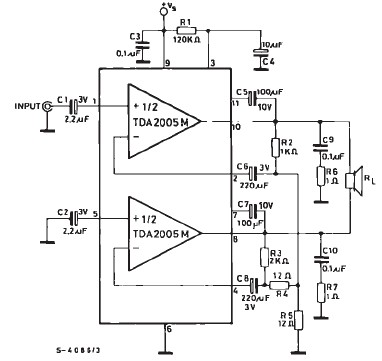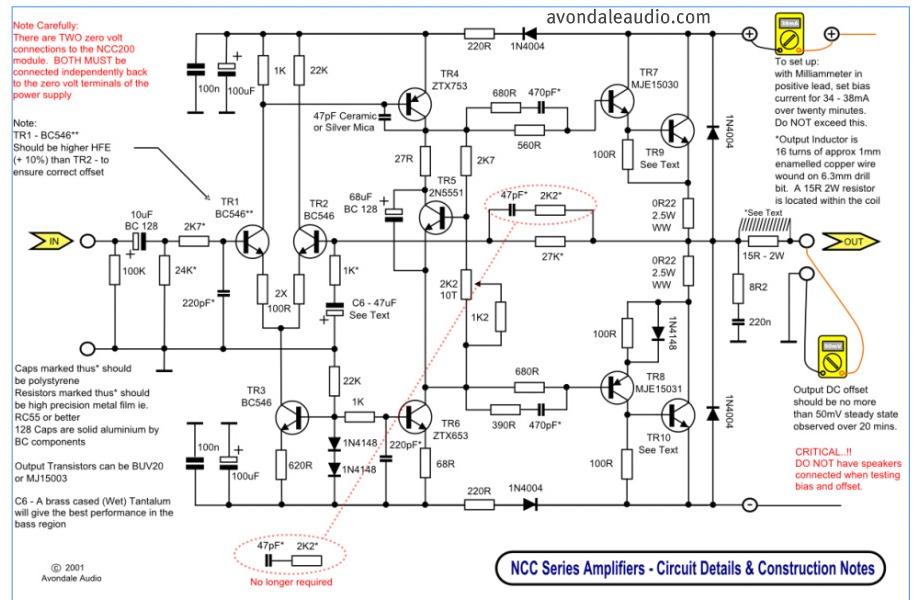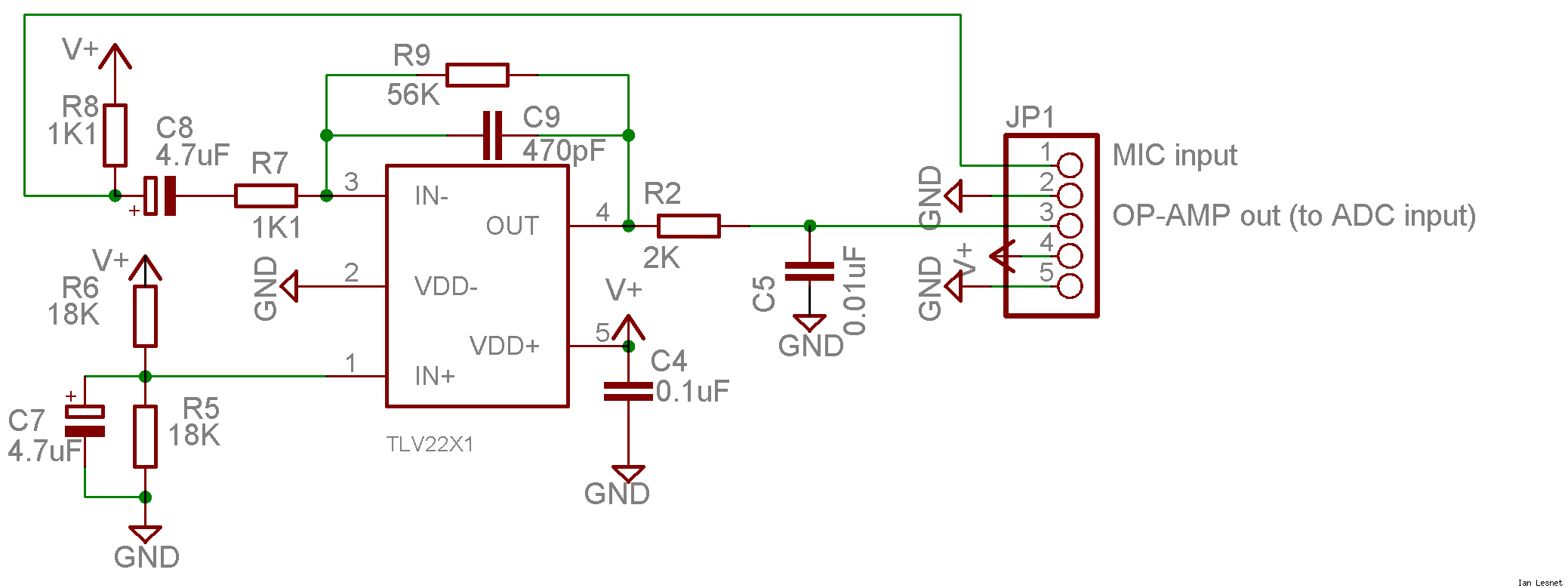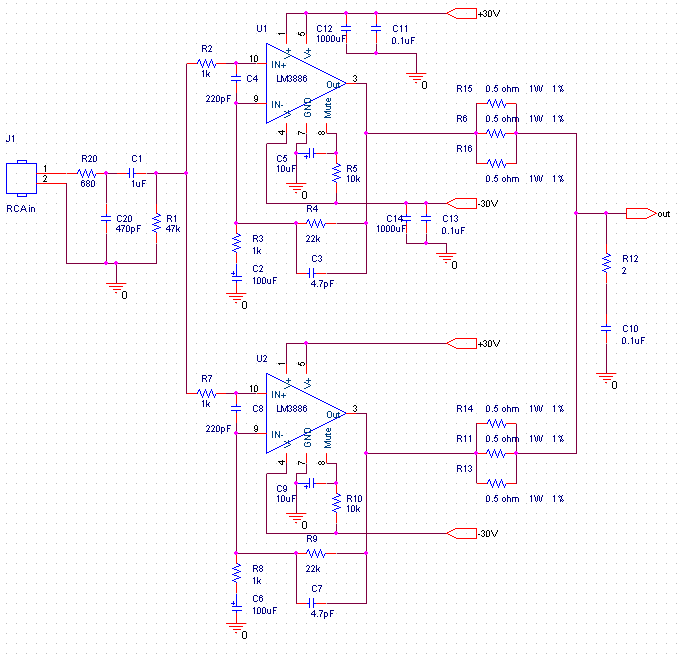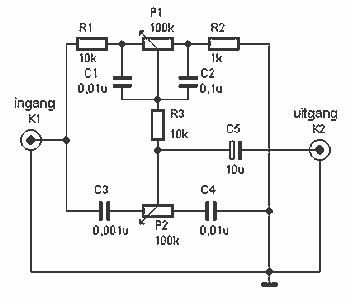
Audio Booster
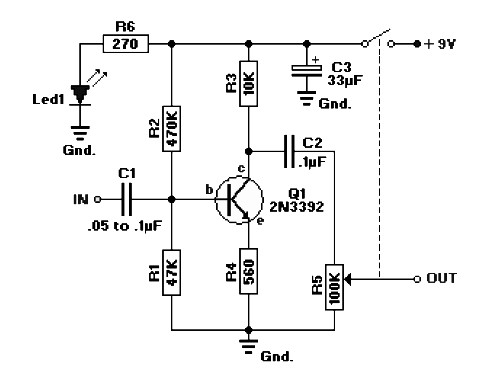
The circuit diagram represents a booster for an audio application. It features a linear potentiometer R5 with a resistance of 100K ohms, which includes an on/off switch. The capacitor C1 should be selected with a value between 0.05 µF and 0.1 µF (47nF/100nF) to optimize performance through experimentation. This audio amplifier operates at 20 watts and is powered by a voltage of 14.4 volts, delivering a total power output of 20 watts across two channels, each connected to a tweeter and a woofer. The amplifier includes an active crossover filter with a crossover frequency set at 2 kHz. Each loudspeaker must handle a power rating of 10 watts and have an impedance of 4 ohms. The supply voltage can range from 12 volts and above.
The audio booster circuit is designed to enhance sound quality by amplifying audio signals while maintaining clarity and fidelity. The linear potentiometer R5 serves as a volume control and on/off switch, allowing for easy adjustment of the audio output level. The choice of capacitor C1 is critical; its value influences the frequency response of the amplifier. A capacitor value within the specified range ensures that the amplifier operates efficiently at the desired frequencies, particularly in the context of the crossover filter.
The amplifier's configuration is optimized for a total output of 20 watts, split evenly across two channels. Each channel drives a tweeter and a woofer, which are essential for reproducing a full range of audio frequencies. The active crossover filter at 2 kHz ensures that high frequencies are directed to the tweeter and low frequencies to the woofer, preventing distortion and enhancing sound quality.
The loudspeakers used in this circuit must be rated for 10 watts of power and have an impedance of 4 ohms, which is a common specification for consumer audio equipment. This impedance allows the amplifier to deliver sufficient power without overloading the speakers. The supply voltage range of 12 volts and above provides flexibility in powering the circuit, accommodating various power supply options while ensuring optimal performance. Overall, this audio booster circuit is well-suited for applications requiring enhanced audio output with precise control over sound quality.Booster for audio circuit diagram. Potentiometer R5 of 100K is a linear type with an on/off switch attached. The value of C1 may need to be between 0. 05 µF and 0. 1 µF (47nF/100nF). Experiment with the value for best performance. This is a20 watts audio amplifieris suppliedwith a voltage14. 4volts, givinga total power of20wattsinto twodifferent chann els, each of whichis connectedto thetweeteranda woofer. This amplifier isthereforeequipped with an active CROSSOVERfilterwithacrossoverfrequencyof 2KHz. Eachloudspeakermust supporta power of 10wattsandhaveanimpedanceof 4 ohms. The supply voltagecan bebetween12and up. 🔗 External reference
The audio booster circuit is designed to enhance sound quality by amplifying audio signals while maintaining clarity and fidelity. The linear potentiometer R5 serves as a volume control and on/off switch, allowing for easy adjustment of the audio output level. The choice of capacitor C1 is critical; its value influences the frequency response of the amplifier. A capacitor value within the specified range ensures that the amplifier operates efficiently at the desired frequencies, particularly in the context of the crossover filter.
The amplifier's configuration is optimized for a total output of 20 watts, split evenly across two channels. Each channel drives a tweeter and a woofer, which are essential for reproducing a full range of audio frequencies. The active crossover filter at 2 kHz ensures that high frequencies are directed to the tweeter and low frequencies to the woofer, preventing distortion and enhancing sound quality.
The loudspeakers used in this circuit must be rated for 10 watts of power and have an impedance of 4 ohms, which is a common specification for consumer audio equipment. This impedance allows the amplifier to deliver sufficient power without overloading the speakers. The supply voltage range of 12 volts and above provides flexibility in powering the circuit, accommodating various power supply options while ensuring optimal performance. Overall, this audio booster circuit is well-suited for applications requiring enhanced audio output with precise control over sound quality.Booster for audio circuit diagram. Potentiometer R5 of 100K is a linear type with an on/off switch attached. The value of C1 may need to be between 0. 05 µF and 0. 1 µF (47nF/100nF). Experiment with the value for best performance. This is a20 watts audio amplifieris suppliedwith a voltage14. 4volts, givinga total power of20wattsinto twodifferent chann els, each of whichis connectedto thetweeteranda woofer. This amplifier isthereforeequipped with an active CROSSOVERfilterwithacrossoverfrequencyof 2KHz. Eachloudspeakermust supporta power of 10wattsandhaveanimpedanceof 4 ohms. The supply voltagecan bebetween12and up. 🔗 External reference
